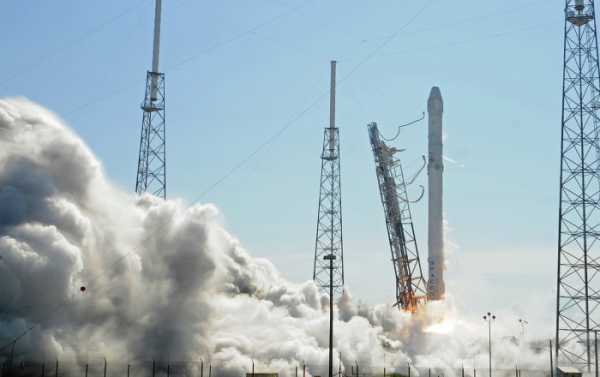
SpaceX received approval Friday from the Federal Communications Commission (FCC) for its ambitious constellation of thousands of broadband satellites. The FCC is worried, however, what the dramatic expansion of man-made objects in low orbit will mean for the growing problem of space junk.
Earlier this year, the FCC gave SpaceX permission to launch 4,425 low-Earth orbit (LEO) satellites, and on Friday it signed off on another 7,518. These 11,943 satellites will form the expansive Starlink broadband network, designed to provide worldwide high speed internet access by ensuring that at least one satellite is always above the horizon for anyone on Earth, the Verge noted.
The novelty behind SpaceX’s approach comes from its extremely low altitude: whereas present internet satellites orbit at roughly 900 miles above Earth, Starlink will be much closer, which the company says will massively boost signal strength and connection speed to levels comparable with cable and fiber systems. The first batch will orbit at around 700 miles up, but the second, larger batch will be very close to the Earth: only 200 miles above our heads, Ars Technica noted.
“From providing high-speed broadband services in remote areas to offering global connectivity to the Internet of Things through ‘routers in space’ for data backhaul, I’m excited to see what services these proposed constellations have to offer,” FCC Chairman Ajit Pai said Friday. “Our approach to these applications reflects this commission’s fundamental approach: encourage the private sector to invest and innovate and allow market forces to deliver value to American consumers.”
The FCC gave SpaceX six years to launch half of the Starlink constellation and nine years to get the whole fleet up, or it’ll require a waiver. The project is expected to have a total cost of $10 billion to develop.
“SpaceX can resubmit this request in the future, when it will have more information about the progress of the construction and launching of its satellites and will therefore be in a better position to assess the need and justification for a waiver,” the FCC wrote.
Right now, SpaceX has only two of those roughly 12,000 satellites in orbit: TinTin A and B, two test satellites it launched in February. The company has dramatically increased its launch capacity this year, with four more scheduled for a total of 22 launches. It’s expanded its payloads, too, with a scheduled launch on Monday carrying 71 small probes for various commercial enterprises on a Falcon 9 rocket dubbed the “SmallSat Express,” Sputnik reported. With Starlink’s satellites expected to be of similar size — between 220 and 1,100 pounds — an ambitious effort could at least put all of them into orbit at its present launch pace.
In addition to SpaceX’s massive operation, the FCC approved three other companies with much smaller projects: 140 satellites for Kepler, 117 for Telesat and 78 for LeoSat, meaning that Friday the agency voted to permit the placing of 7,859 more human-made objects into orbit.
When you consider there are only 1,886 operating satellites orbiting Earth right now, and the concerns already raised about space debris with those numbers, the concern about dangers from collisions or rogue objects from increasing that number six times over becomes much more acute.
In addition to functional objects that might collide, there are roughly 500,000 pieces of space junk flying around, many of which are so small “they can’t be tracked,” according to NASA, the US space agency.
“One of the issues that we have with the space junk problem,” Alice Gorman, an internationally recognized leader in the field of space archaeology and senior lecturer at Flinders University, told Sputnik earlier this year, is that “we don’t know precisely where a lot of objects are.”
“When you try to model these millions of bits of stuff circling around the Earth in order to make space safer for functioning satellites, it’s just so complex; it’s a really difficult task,” she explained.
In April, a prototype satellite dubbed RemoveDEBRIS was launched into orbit by the European Commission and a number of private partners to test a space trash removal effort that involves capturing debris with a harpoon and net, Sputnik reported.
As a result of the space junk issue, the FCC asked SpaceX to submit debris mitigation plans.
“[W]hile we appreciate the level of detail and analysis that SpaceX has provided for its orbital-debris mitigation and end-of-life disposal plans, we conclude that the unprecedented number of satellites proposed by SpaceX and the other NGSO FSS [fixed-satellite service] systems in this processing round will necessitate a further assessment of the appropriate reliability standards of these spacecraft, as well as the reliability of these systems’ methods for deorbiting the spacecraft,” the FCC said. “Accordingly, we condition grant of the application on SpaceX presenting and the Commission granting a modification of this space station grant to include a final orbital debris mitigation plan.”
Starlink’s novelty has inspired the Pentagon, too, which seeks to pioneer a generation of cheap, disposable, lightweight satellites through its Blackjack program, spearheaded by the Defense Department’s Defense Advanced Research Projects Agency (DARPA), Sputnik reported.
In May, DARPA announced a $117.5 million project to adapt Starlink’s technology for spy and navigation satellites to replace the US military’s aging fleet of giant and expensive satellites, which it fears are vulnerable to interception or interruption by hostile powers such as Russia and China in the event of conflict. Project developer Paul Thomas told Space.com that if all goes well, the US could have a 90-satellite constellation in operation at a 620-mile altitude by 2022. Geostationary satellites presently orbit at a distant 22,000 miles away.
Sourse: sputniknews.com






